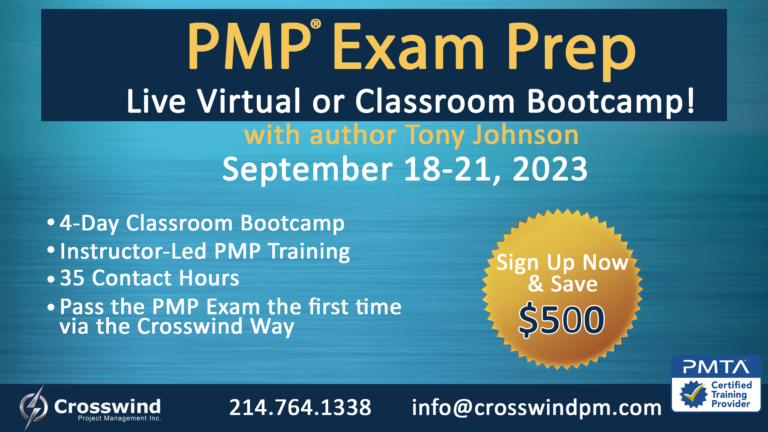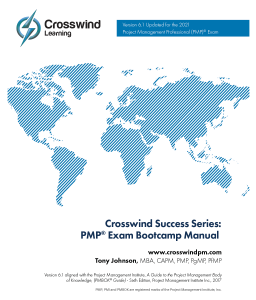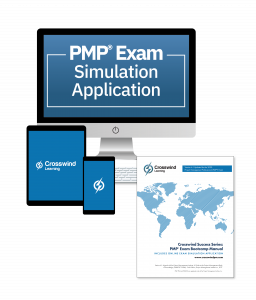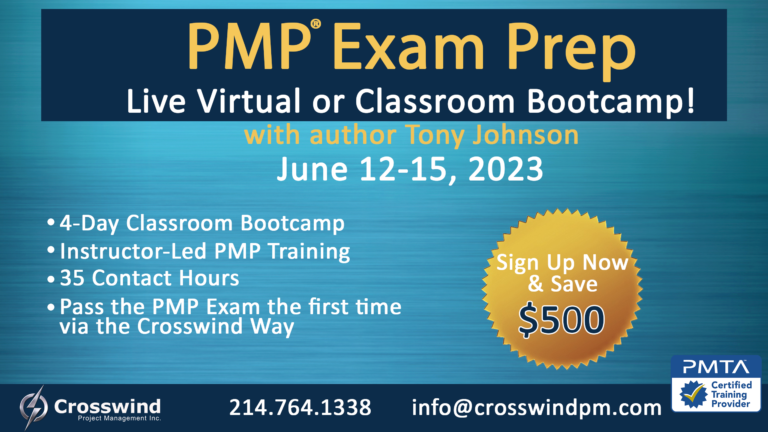Free PMP Terms and Definitions
Understanding common project management terms can be a challenge for all project managers. To help you understand those terms and definitions Crosswind Project Management has created a free to use glossary to help in your pmp training. In this page you will find the terms and definitions associated within the component areas of framework to get a better understanding of how this process works and relates to project management.
In project management, framework is a method used to create and evolve the product, service, or result during the project life cycle, such as a predictive, iterative, incremental, adaptive, or hybrid method.
Sign Up for a daily free Tip of The Day!
| Term | Definition |
|---|---|
| Adaptive Approach | A development approach where requirements can be uncertain and volatile throughout the project because change is expected. |
| Agile | An iterative software development approach, expressed in a variety of methodologies, which embraces incremental delivery, flexibility, cross-functional and self-organizing teams, direct customer-developer communication and collaboration, and frequent inspection and adaptation |
| Agile Life Cycles | A life cycle that can be iterative or incremental in nature. Commonly called change-driven and applied when there is a high degree of change expected, or uncertainty present. |
| Agile Manifesto | Declaration of values and principals for Agile development including prioritizing individuals over processes and working software over extensive documentation |
| Agile Project Management | A project management framework that applies iterative or incremental development approaches, with an emphasis on value delivery and empowering the team. |
| Agile Release Planning | The approach to determine the number of iterations or sprints needed to complete a release. Included are the features that will be in each iteration or sprint that come together to make up the release. |
| Approved Change Request | A modification request that has been authorized as a result of undergoing the integrated change control process |
| Backlog | An evolving list of customer-prioritized stories, tasks, and bugs that have not been completed and are not being worked on during the current iteration |
| Backlog Item | Any story, task, or bug that has not been completed and is not being worked on during the current iteration |
| Backlog Refinement | Continuously updating the prioritized product backlog to reflect any changes, including adding new items, removing items that are no longer appropriate, reprioritizing existing items as necessary, and refining/cleaning user stories to get them ready for planning and execution |
| Burn Chart | A graphical representation of the product work in an iteration or the project. |
| Burndown Chart | A graphical representation of the work (represented by story points for a release and hours for an iteration) remaining over time |
| Burnup Chart | A graphical representation of the work that has been completed over time plotted against the total work |
| Business Case | A document that attempts to prove the economic feasibility of a business idea, such as a product or service, to justify the project |
| Business Model Canvas | Commonly used in lean startups. A one-page, visual summary of the value proposition, customers, infrastructure, customers, and finances of the environment. |
| Business Value | An abstraction that includes tangible and intangible elements associated with project, program, and portfolio management that maximize the value to the organization |
| Change | A modification to any deliverable, project management plan component, or project document subject to the formal change control process. |
| Change Control | The process of determining, documenting, reviewing, and then approving or rejecting any proposed modifications to project documentation, deliverables, or baselines |
| Change Control Board (CCB) | The group accountable for considering, appraising, and making decisions about (approval, postponement, or rejection) proposed project changes and for the documenting and communicating those decisions |
| Change Control Plan | A component of the project management plan that defines the change control board (CCB), their authority, and how the change control system will be applied. |

Crosswind’s 35 Contact Hour PMP Exam Prep Course Bundle offers the best PMP certification training. This 4 day course is taught by author Tony Johnson will help you pass the PMP Exam the first time via the Crosswind Way!
| Term | Definition |
|---|---|
| Change Control System | The procedures that govern modifications to project documents, deliverables, and baselines |
| Change Log | A list of proposed project modifications and their associated details including description, date, requestor, and status |
| Change Management | A proactive approach to controlling, communicating, and responding effectively to fluctuations |
| Change Management Plan | A plan that defines the project change management process |
| Change Request | A formal solicitation for a project modification that relates to the approach to, or outcome of, the project. Sometimes called a change control form |
| Closing Process Group | The group of activities associated with concluding the project or phase |
| Crystal | A family of light software development methodologies |
| Crystal Clear | A light software development methodology for small (usually 6 or 8 collocated members) teams |
| Crystal Orange | A light software development methodology for medium (usually 10-40 members) teams |
| Cumulative Flow Diagram (CFD) | A chart that displays features completed over time, in various stages of development, and those in the backlog. |
| Daily Standup | Sometimes called the daily scrum. Team meeting held on a daily basis used to share the daily reality (what you have done since the last daily scrum, what you will do until the next daily scrum, and what impediments stand in your way) and to adapt to that reality, which usually involves an immediate replanning meeting and additional meetings |
| Definition of Done DOD) | A Scrum term representing the objective criteria used to determine if a story meets internal standards/constraints |
| Definition of Ready (DOR) | A checklist the team uses to establish they have everything needed to start work on the project or product. |
| Development Approach | The method (predictive, iterative, incremental, agile, or hybrid) utilized during the project life cycle to produce and elaborate the product, service, or result of the project. |
| Development Approach and Life Cycle Performance Domain | The performance domain that focuses on activities and functions for the project development approach, cadence, and life cycle phases. |
| DevOps | An approach that focuses on a smooth flow of work completion from development to operations. |
| Executing Process Group | The processes performed to achieve the work detailed in the project management plan in order to meet the requirements delineated in the project specifications per the work identified in the project management plan |
| Hybrid Approach | A project approach that utilizes two or more agile and non-agile elements that results in a non-agile outcome. |
| Ideal Days/Hours | A unit of time (in days or hours) exclusively allocated to a given task, that is a unit of time where no other work is performed or interruptions occur |
| Ideal Time | A unit of time exclusively allocated to a given task, i.e., a unit of time where no other work is performed or interruptions occur |

Crosswind 2022 PMP Exam Bootcamp Manual
The PMP Exam Bootcamp Manual provides a foundation for the PMP Exam. This manual comes with a complete 200 question exam simulation application and 50/100 question ITTO exams created with over 1,400 ITTO questions in the data base.
| Term | Definition |
|---|---|
| Impediment | Anything that prevents the team from working efficiently and effectively |
| Incremental Approach | An adaptive development approach where deliverables are created over time with functionality added until the functionality is determined complete. |
| Incremental Life Cycle | The progression of project phases characterized by an early determination of scope, the adjustment of time and cost estimates as the team learns more about the product, and an increase in functionality resulting from incremental delivery |
| Information Radiator | A wall in the common workspace that contains highly visible, graphic representations of progress |
| Initiating Process Group | The processes associated with the inauguration of a new project or phase; typically involves obtaining approval and identifying project stakeholders |
| Iteration | A timebox cycle to create a product or deliverable where all the work is completed. |
| Iteration 0 (Zero) | Iteration 0 sets the stage for Iteration 1 and beyond by ensuring that the vision statements for the project and release have been prepared, the features in the product backlog have been prioritized and estimated; the stories have been decomposed, the length of the iteration has been set; the team is adequately staffed, the team is co-located, the definition of done is established, the team environment is acceptable, and the architecture has been determined |
| Iteration Plan | The work plan for the current iteration. |
| Iteration Planning | A planning meeting that includes backlog items, acceptance criteria, and work estimates to complete the iteration. In scrum, commonly called a sprint planning meeting. |
| Iteration Review | A meeting held at the end of an iteration to review the work completed during that iteration. In scrum, called a retrospective. |
| Iterative Approach | A development approach that begins with a simple implementation, then expands by adding features until the final deliverable, or outcome is complete. |
| Iterative Life Cycle | The progression of project phases characterized by the development of scope details one iteration at a time, the adjustment of time and cost estimates as the team learns more about the product, and an increase in functionality resulting from iterative development |
| Joint application development (JAD) | A method that involves the product owner/customer or user in the design and development of the product |
| kanban | Signal cards used in manufacturing to assist flow; used to indicate when new work can be pulled into the flow and when there is a stoppage in flow |
| Kanban Board | A visual tool that shows work in progress to identify bottlenecks and overallocations, so that the team can optimize the workflow. |
| Kano Analysis | A model for customer satisfaction that categorizes features as Must Haves, Linear (the more, the better), Exciters/Delighters, or Dissatisfiers |
| Lean | A methodology that emphasizes the elimination of waste, producing only what is valuable to the customer |
| Lean Startup Canvas | A one-page template to communicate the business plan to key stakeholders as effectively as possible. |
| Life Cycle | The phases of a project associated with the work of the project, as opposed to being associated with its project management |
| Life Cycle Assessment (LCA) | An approach to assess the complete environmental impact of a product, process, or system. |
| Lost Iteration | An iteration that does not result in a deliverable |
| Overlapping Relationship | A relationship between project phases where one starts before the predecessor finishes. |
| Pair Programming | An extreme programming practice that pairs two programmers at one station, typically with one programmer coding (driver) and one reviewing (navigator); an excellent cross-training device |

Crosswind PMP Prep Bootcamp Manual and Premium PMP Exam Simulator Bundle 2022 Exam
With over 4,800 questions and 130 different test options available, The Crosswind PMP Exam Simulation Application is the most detailed Project Management Professional (PMP)® exam product on the market. Quizzes are available by knowledge area and exam domains as well as calculations, terminology, definitions. For added initiative, the exam allows you to randomize your questions and answers to keep every test unfamiliar and applicable. Attack the exam with confidence and competency. Success is yours when you work with Crosswind!
| Term | Definition |
|---|---|
| Phase Gate | A review which is conducted at the end of a phase to decide if the project should continue to the next phase, if the project should continue to the next phase with modification, or if the project or program should be terminated. |
| Planning Process Group | The processes required to create the management and other planning documents that comprise the project management plan |
| Predictive Life Cycle | A life cycle type that determines project scope, time, and cost during the early phases of the life cycle. |
| Product Life Cycle | The phases of product development, typically defined as conception through delivery, expansion, maturity, and disengagement |
| Product Roadmap | The description of how the project will proceed from its current state to the state described in the vision statement |
| Progressive Elaboration | The iterative process of increasing the level of detail in accordance with the increase in information discovery and estimation accuracy |
| Project Life Cycle | The phases, from initiation through closure, of a project associated with the work of the project, as opposed to being associated with its project management |
| Project Management Process Group | The aggregation of the processes, along with their inputs, outputs, tools, and technique, that make up project management including initiating, planning, executing, monitoring and controlling, and closing |
| Project Phase | An aggregation of logically related activities that results in the completion of a deliverable or deliverables |
| Project Vision Statement | A document that defines the goal of the project, typically referencing the target customer, the need or opportunity, and the key benefit; often includes the main alternative to the project and why the project goal is more desirable |
| Relative Authority | The authority that the project manager has relative to the functional manager's authority over the project team and project environment. |
| Release | A deployable software package that incorporates several iterations |
| Release Management | Activities performed to ensure that the software is ready for release to the customer |
| Release Plan | A plan that defines iterations, dates and features or outcomes to be delivered over multiple iterations. |
| Release Planning | Defining the prioritized and estimated stories from the product backlog that will be developed in the release and determining the date of the release |
| Roadmap | A document that contains the high-level plan of the features that will be developed during the next few releases; the product owner/customer owns and maintain the document |
| Rolling Wave Planning | Preparing in more detail as the project becomes clearer |
| Scrum | An Agile methodology that delivers finished increments of a product at the end of each Sprint (a timeboxed iteration with a duration of one to four weeks) |
| Scrum of Scrums | A planning forum used in multiple-team projects to coordinate resources and dependencies |
| Scrum Values | Openness, focus, commitment, courage, visibility, and humor |

Crosswind 2022 PMP Prep System
The Crosswind PMP Exam Prep Certification Study System provides everything you need in order to transform your studying into a successful testing experience. Obtain your PMP certification with ease using this comprehensive study system. Aligned with the 2022 PMP Exam Content Outline (ECO).
| Term | Definition |
|---|---|
| Sprint | An abbreviated development cycle (typically 30 days) that results in potentially shippable product |
| Sprint Backlog | The list of stories scheduled for the current iteration |
| Sprint Planning | A meeting between the product owner and the team to prioritize and identify stories for the next Sprint |
| Sprint Retrospective Meeting | A meeting held at the end of each Sprint in which the ScrumMaster and the team discuss what went well and what could be improved during the next Sprint; part of the inspect and adapt philosophy |
| Sprint Review | An informal meeting at the end of the Sprint to demonstrate to the product owner what was accomplished during the Sprint |
| Story Map | A graphical model for the team to see all the features and functions with a product, so they know what they are building and why they are building it. |
| Story Point | A measurement that defines the size and complexity of a story/user story relative to a previously estimated story/user story |
| Storyboarding | A prototype method that uses graphics or images to show how a process or outcome should flow, and how the product, service, or application should work when complete. |
| Tailoring | The determination of the conglomeration of processes, inputs, tools, techniques, outputs, and life cycle phases appropriate to the management of a project. |
| Task (Agile) | A decomposed portion of a story/user story |
| Task (Predictive) | An activity to be completed on the project |
| Task board | A surface upon which tasks written on cards are grouped under their user stories and pinned in priority order; used to track the progress of the project |
| Technical Debt | An obligation incurred as a result of an opportunistic design or architectural approach which results in complexity and increased costs in the long term; can also refer to code that will be difficult to maintain as a result of ignoring the definition of done, writing poor |
| Timebox | A fixed duration of time that cannot be expanded |
| User Story | A document describing a unit of functionality written in business language that is used as the basis of conversation between the product owner/customer and the team to elicit functionality details; a user story is independent, negotiable, valuable, estimable, small, and testable |
| Value Delivery System | Tasks associated with building, sustaining, and evolving an organization with project and product work. |
| Value Proposition | The reasoning behind why an organization does or should do something. |
| Velocity | The rate at which stories are completed during an iteration, typically measured in story points; also known as team velocity |
| Velocity Chart | A chart that shows the rate (typically in points) that deliverables are produced, tested, and accepted within a set time interval. |
| Vision Statement | A document that defines the goal of the project, typically referencing the target customer, the need or opportunity, and the key benefit; often includes the main alternative to the project and why the project goal is more desirable |
| Volatility | The potential for unpredictable and rapid change in a project or product environment. |

Crosswind’s 35 Contact Hour PMP Exam Prep Course Bundle offers the best PMP certification training. This 4 day course is taught by author Tony Johnson will help you pass the PMP Exam the first time via the Crosswind Way!
